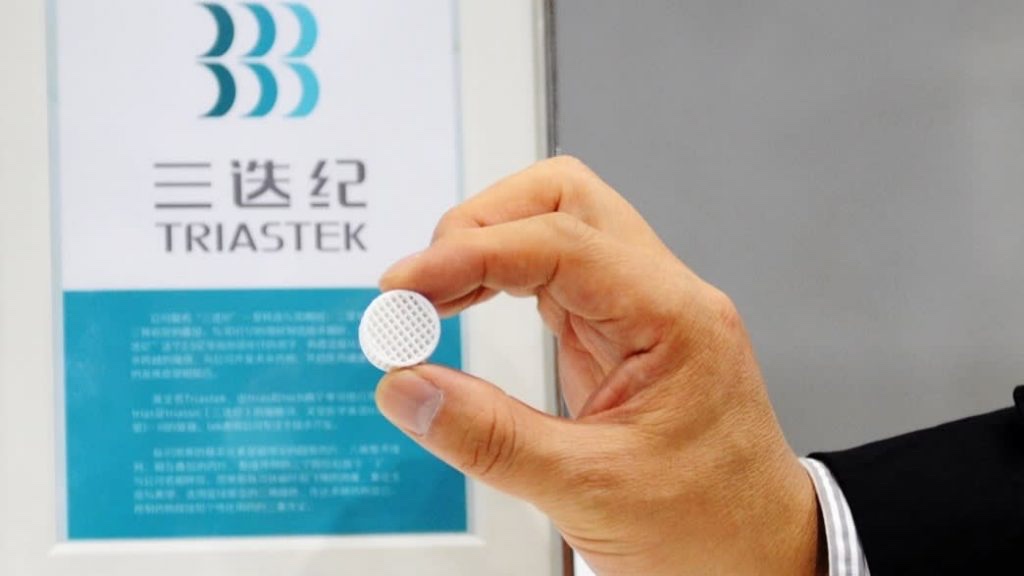Triastek and Eli Lilly have announced that the two companies will collaborate on the research of new applications for 3D printed pharmaceuticals. Specifically, the research will focus on utilizing Triastek’s proprietary melt extrusion deposition (MED) technology to 3D print timed-release, orally administered drugs.
Indianapolis-based Eli Lilly is, of course, one of the world’s largest pharmaceutical manufacturers, and the largest manufacturer of psychiatric drugs. It is entering into the present collaboration via Lilly China Innovation & Partnerships. Triastek, founded in 2015, is a Chinese pharmaceutical additive manufacturing (AM) company, headquartered in Nanjing.

Triastek’s first two applications, the T19 and T20, have been given IND clearance from the FDA, which means that clinical trial of both drugs is permitted. T19, for the treatment of rheumatoid arthritis, received IND clearance at the beginning of 2021, and Triastek expects to file its New Drug Application (NDA) in 2023. T20 treats cardiovascular and clotting disorders, and got its IND clearance in April of this year. Triastek plans on filing the T20’s NDA in 2025. Presumably, then, the latest announcement means that Eli Lilly will be in charge of the clinical trials for the T19 and T20, at the very least.
The idea behind both drugs is to capitalize on AM’s ability to produce shapes unachievable by conventional methods, in order to create unique delivery solutions that can improve the drugs’ bioavailability. There are two main components to the testing planned by Triastek and Eli Lilly. To begin, the researchers will focus on how best to maintain stability, both in the manufacturing process as well as during the drug’s release, by studying how the process parameters of design affect the pharmaceuticals’ excipient properties. Basically, the latter are properties that aren’t medicinal, but rather determine how the body metabolizes the drug.

Next, the researchers will use the knowledge gained by the first step to attempt to identify particular three-dimensional designs that achieve programmed, or timed, release. The unique shapes facilitated by AM allow for control over when the drug will hit various parts of the intestinal tract, which, in turn, maintains consistent levels of the drug in the patient’s system throughout the day.
The small but noticeable increased interest in 3D printed pharmaceuticals activity is instructive concerning the whole AM sector. Across virtually all the subdivisions within AM, the technology has still only very recently moved beyond the R&D phase. Further, the utilization of the technology to fill supply chain gaps is even more recent. Along these lines, it’s still difficult to say, which AM applications will prove to be most successful in the long run.
Thus, the relatively lower level of activity in printed drugs, at this point, isn’t necessarily an indicator of how things will shake out by the end of the decade. Keeping Triastek’s current NDA timeline projections in mind, for instance, by 2025, some critical mass in FDA approvals could be reached, and pharmaceuticals could start to become a more common applications for AM. To sum up, then, while it may be most apparent with industries like aerospace and drugs, the examples set in these industries reveal how much the sector’s success over the next decade will be dependent on the establishment of federal regulatory precedents.
Images courtesy of Triastek
Subscribe to Our Email Newsletter
Stay up-to-date on all the latest news from the 3D printing industry and receive information and offers from third party vendors.
Print Services
Upload your 3D Models and get them printed quickly and efficiently.
You May Also Like
Reinventing Reindustrialization: Why NAVWAR Project Manager Spencer Koroly Invented a Made-in-America 3D Printer
It has become virtually impossible to regularly follow additive manufacturing (AM) industry news and not stumble across the term “defense industrial base” (DIB), a concept encompassing all the many diverse...
Inside The Barnes Global Advisors’ Vision for a Stronger AM Ecosystem
As additive manufacturing (AM) continues to revolutionize the industrial landscape, Pittsburgh-based consultancy The Barnes Global Advisors (TBGA) is helping shape what that future looks like. As the largest independent AM...
Ruggedized: How USMC Innovation Officer Matt Pine Navigates 3D Printing in the Military
Disclaimer: Matt Pine’s views are not the views of the Department of Defense nor the U.S. Marine Corps Throughout this decade thus far, the military’s adoption of additive manufacturing (AM)...
U.S. Congress Calls Out 3D Printing in Proposal for Commercial Reserve Manufacturing Network
Last week, the U.S. House of Representatives’ Appropriations Committee moved the FY 2026 defense bill forward to the House floor. Included in the legislation is a $131 million proposal for...

































